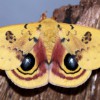 The beautiful Io moth is one of our most recognizable moths, because of its prominent hind wing eyespots. The attractive Io moth caterpillar is also well-known because of its painful sting. But like many of the other saturniid moths, is less common now in parts of its range. With the exception of Cape Cod and some of the Massachusetts islands, it is now rare in New England where it was once common, and its populations have declined in most of the Gulf States since the 1970s. This 12-page fact sheet was written by Donald W. Hall, and published by the UF Department of Entomology and Nematology, December 2014. (Photo: Donald W. Hall, UF/IFAS)
The beautiful Io moth is one of our most recognizable moths, because of its prominent hind wing eyespots. The attractive Io moth caterpillar is also well-known because of its painful sting. But like many of the other saturniid moths, is less common now in parts of its range. With the exception of Cape Cod and some of the Massachusetts islands, it is now rare in New England where it was once common, and its populations have declined in most of the Gulf States since the 1970s. This 12-page fact sheet was written by Donald W. Hall, and published by the UF Department of Entomology and Nematology, December 2014. (Photo: Donald W. Hall, UF/IFAS)
http://edis.ifas.ufl.edu/in1065
Tag: Moths
Imperial Moth Eacles imperialis imperialis (Drury, 1773) (Insecta: Lepidoptera: Saturniidae: Ceratocampinae)
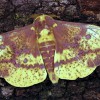 The imperial moth is one of our largest and most beautiful moths. It is also the most variable in appearance and the most widely distributed of our large eastern U.S. saturniid moths. This 9-page fact sheet was written by Donald W. Hall, and published by the UF Department of Entomology and Nematology, September 2014.
The imperial moth is one of our largest and most beautiful moths. It is also the most variable in appearance and the most widely distributed of our large eastern U.S. saturniid moths. This 9-page fact sheet was written by Donald W. Hall, and published by the UF Department of Entomology and Nematology, September 2014.
(Photo: Donald W. Hall, University of Florida) http://edis.ifas.ufl.edu/in1051
Giant Woolly Bear (larva), Giant or Great Leopard Moth (adult) Hypercompe scribonia (Stoll 1790) (Lepidoptera: Erebidae: Arctiinae)
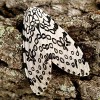 The giant leopard moth is our largest eastern tiger moth. It was formerly in the family Arctiidae, which now composes the subfamily Arctiinae in the family Erebidae. Giant leopard moths are nocturnal. Males are commonly attracted to lights at night. Sometimes dozens of males come to bright lights set out in good habitat. This 6-page fact sheet was written by Donald W. Hall, and published by the UF Department of Entomology and Nematology, August 2014.
The giant leopard moth is our largest eastern tiger moth. It was formerly in the family Arctiidae, which now composes the subfamily Arctiinae in the family Erebidae. Giant leopard moths are nocturnal. Males are commonly attracted to lights at night. Sometimes dozens of males come to bright lights set out in good habitat. This 6-page fact sheet was written by Donald W. Hall, and published by the UF Department of Entomology and Nematology, August 2014.
http://edis.ifas.ufl.edu/in1043
Erythrina leafminer (suggested common name); Leucoptera erythrinella Busck, 1900 (Insecta: Lepidoptera: Lyonetiidae)
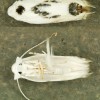 The erythrina leafminer is a member of the genus Leucoptera, which are leaf borers that can cause severe damage to plant crops, such as coffee or apples. Even though these moths are 1/20 to 1/10 the size of an average moth, they can cause serious damage. Leucoptera erythrinella is a pest of the coral bean and other members of the genus Erythrina. The larvae feed inside the leaves, making elaborate and characteristic mines, which from a distance appear to be discolorations of the leaf itself. This 5-page fact sheet was written by Andrei Sourakov, and published by the UF Department of Entomology and Nematology, January 2014.
The erythrina leafminer is a member of the genus Leucoptera, which are leaf borers that can cause severe damage to plant crops, such as coffee or apples. Even though these moths are 1/20 to 1/10 the size of an average moth, they can cause serious damage. Leucoptera erythrinella is a pest of the coral bean and other members of the genus Erythrina. The larvae feed inside the leaves, making elaborate and characteristic mines, which from a distance appear to be discolorations of the leaf itself. This 5-page fact sheet was written by Andrei Sourakov, and published by the UF Department of Entomology and Nematology, January 2014.
http://edis.ifas.ufl.edu/in1023
Cactus Moth, Cactoblastis cactorum (Berg) (Insecta: Lepidoptera: Pyralidae) (EENY056/IN213)
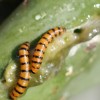 Since its arrival in the Florida Keys in 1989, this invasive species has become a serious threat to the diversity and abundance of Opuntia cactus in North America. The spread of this moth raises concerns about harm to rare opuntioid species (prickly pear and related cacti), the endangerment of wild opuntioids in the southwestern United States and Mexico and the consequent effects on entire desert ecosystems and economic hardship for communities in Mexico that cultivate and sell Opuntia. This 5-page fact sheet was written by D. H. Habeck, F. D. Bennett, and Christine Miller, and published by the UF Department of Entomology and Nematology, September 2012.
Since its arrival in the Florida Keys in 1989, this invasive species has become a serious threat to the diversity and abundance of Opuntia cactus in North America. The spread of this moth raises concerns about harm to rare opuntioid species (prickly pear and related cacti), the endangerment of wild opuntioids in the southwestern United States and Mexico and the consequent effects on entire desert ecosystems and economic hardship for communities in Mexico that cultivate and sell Opuntia. This 5-page fact sheet was written by D. H. Habeck, F. D. Bennett, and Christine Miller, and published by the UF Department of Entomology and Nematology, September 2012.
http://edis.ifas.ufl.edu/in213
EENY478/IN861 Cecropia Moth, Cecropia Silk Moth, Robin Moth, Hyalophora cecropia Linnaeus (Insecta: Lepidoptera: Saturniidae: Saturniinae: Attacini)
EENY478, a 5-page illustrated fact sheet by Geoffrey R. Gallice, is part of the Featured Creatures collection. It describes this spectacular member of the Saturniidae family — synonymy, distribution, hosts, and economic importance. Includes references. Published by the UF Department of Entomology and Nematology, July 2010.
http://edis.ifas.ufl.edu/in861